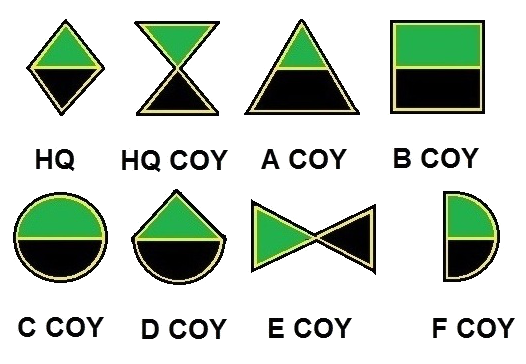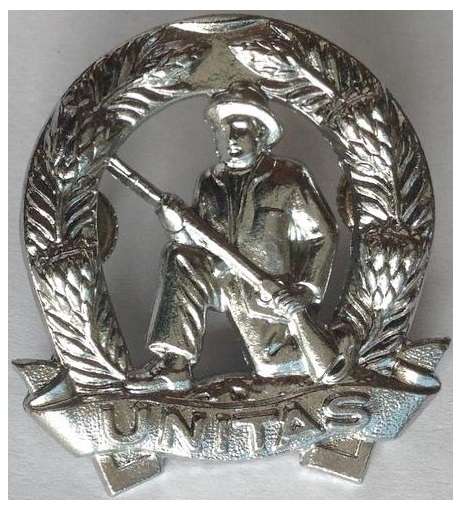|
Vanderbijl Park Commando
Vanderbijl Park Commando was a light infantry regiment of the South African Army. It formed part of the South African Army Infantry Formation as well as the South African Territorial Reserve. History This unit, along with all other Commando units was disbanded after a decision by South African President Thabo Mbeki to disband all Commando Units. The Commando system was phased out between 2003 and 2008 "because of the role it played in the apartheid era", according to the Minister of Safety and Security Charles Nqakula Charles Nqakula (born 13 September 1942) is a South African politician who served as Minister of Defence from September 2008 to 2009. He also served as Minister for Safety and Security from May 2002 to September 2008. Nqakula is married to fo .... Leadership References See also * South African Commando System Infantry regiments of South Africa South African Commando Units {{SouthAfrica-mil-stub ... [...More Info...] [...Related Items...] OR: [Wikipedia] [Google] [Baidu] |
Infantry
Infantry is a military specialization which engages in ground combat on foot. Infantry generally consists of light infantry, mountain infantry, motorized infantry & mechanized infantry, airborne infantry, air assault infantry, and marine infantry. Although disused in modern times, heavy infantry also commonly made up the bulk of many historic armies. Infantry, cavalry, and artillery have traditionally made up the core of the combat arms professions of various armies, with the infantry almost always comprising the largest portion of these forces. Etymology and terminology In English, use of the term ''infantry'' began about the 1570s, describing soldiers who march and fight on foot. The word derives from Middle French ''infanterie'', from older Italian (also Spanish) ''infanteria'' (foot soldiers too inexperienced for cavalry), from Latin '' īnfāns'' (without speech, newborn, foolish), from which English also gets '' infant''. The individual-soldier term ''infantry ... [...More Info...] [...Related Items...] OR: [Wikipedia] [Google] [Baidu] |
South African Infantry Corps
The South African Army Infantry Formation supervises all infantry within the South African Army. History Origins: Union Defence Force South African Infantry originated as the ''Infantry Branch'' of the Union Defence Forces in 1913. In 1915, the defence forces established the South African Overseas Expeditionary Force for war service outside Southern Africa. It included the ''South African Infantry'', comprising twelve battalions, and the ''Cape Corps'', comprising two battalions of Coloured volunteers. These units were disbanded in 1919. The Infantry Branch was enlarged in 1934, and the mounted rifles regiments were converted to infantry in 1935. In 1943, the Infantry Branch was incorporated into the new South African Armoured Corps, which was divided into armour and infantry branches after World War II. Republic Defence Force (SADF) Separated by language Based on the findings of a committee led by Brigadier H.B. Popper in late 1953, it was recommended that some Engli ... [...More Info...] [...Related Items...] OR: [Wikipedia] [Google] [Baidu] |
Vanderbijl Park
Vanderbijlpark is an industrial town with approximately 95 000 inhabitants, situated on the Vaal River in the south of Gauteng province, South Africa. The city is named after Hendrik van der Bijl, an electrical engineer and industrialist. Vanderbijlpark is home to Vanderbijlpark Steel, previously part of the South African Iron and Steel Corporation ( ISCOR), which subsequently became a subsidiary of the global company ArcelorMittal. With neighbouring cities Vereeniging and Sasolburg, it forms the Vaal Triangle, historically a major industrial region of South Africa. It is situated in the local municipality of Emfuleni and district municipality of Sedibeng. The peri-urban black townships Boipatong, Muvango, Bophelong, Sebokeng, Evaton, Tshepiso and Sharpeville are close to the city. History In 1920, Dr HJ van der Bijl, a young South African electrical engineer working in the United States at the time, was called back to South Africa by the then prime minister Jan ... [...More Info...] [...Related Items...] OR: [Wikipedia] [Google] [Baidu] |
Light Infantry
Light infantry refers to certain types of lightly equipped infantry throughout history. They have a more mobile or fluid function than other types of infantry, such as heavy infantry or line infantry. Historically, light infantry often fought as Reconnaissance, scouts, Raid (military), raiders, and skirmisher, skirmishers. These are loose formations that fight ahead of the main army to harass, delay, disrupt supply lines, engage the enemy’s own skirmishing forces, and generally "soften up" an enemy before the main battle. Light infantrymen were also often responsible for Screening (tactical), screening the main body of a military formation. Post-World War II, the term "light infantry" evolved to include rapid-deployment units (including commandos and Airborne forces, airborne units) that emphasize speed and mobility over armor and firepower. Some units or battalions that historically held a skirmishing role have kept their designation "light infantry" for the sake of traditi ... [...More Info...] [...Related Items...] OR: [Wikipedia] [Google] [Baidu] |
Regiment
A regiment is a military unit. Its role and size varies markedly, depending on the country, service and/or a specialisation. In Medieval Europe, the term "regiment" denoted any large body of front-line soldiers, recruited or conscripted in one geographical area, by a leader who was often also the feudal lord ''in capite'' of the soldiers. Lesser barons of knightly rank could be expected to muster or hire a company or battalion from their manorial estate. By the end of the 17th century, infantry regiments in most European armies were permanent units, with approximately 800 men and commanded by a colonel. Definitions During the modern era, the word "regiment" – much like "corps" – may have two somewhat divergent meanings, which refer to two distinct roles: # a front-line military formation; or # an administrative or ceremonial unit. In many armies, the first role has been assumed by independent battalions, battlegroups, task forces, brigades and other, similarly s ... [...More Info...] [...Related Items...] OR: [Wikipedia] [Google] [Baidu] |
South African Army
The South African Army is the principal land warfare force of South Africa, a part of the South African National Defence Force (SANDF), along with the South African Air Force, South African Navy and South African Military Health Service. The Army is commanded by the Chief of the Army, who is subordinate to the Chief of the SANDF. Formed in 1912, as the Union Defence Force in the Union of South Africa, through the amalgamation of the South African colonial forces following the unification of South Africa. It evolved within the tradition of frontier warfare fought by Boer Commando (militia) forces, reinforced by the Afrikaners' historical distrust of large standing armies. Following the ascension to power of the National Party, the Army's long-standing Commonwealth ties were afterwards cut. The South African Army was fundamentally changed by the end of Apartheid and its preceding upheavals, as the South African Defence Force became the SANDF. This process also led to ... [...More Info...] [...Related Items...] OR: [Wikipedia] [Google] [Baidu] |
South African Commando System
The Commando System was a mostly voluntary, part-time force of the South African Army, but in their role as local militia the units were often deployed in support of and under the authority of the South African Police. Mission South Africa's Commando System was responsible for the safeguarding and protection of specific communities (usually rural, but sometimes urban). Commando units were usually referred to as area protection, a system which involved the whole community. The participants in the Commando System did not have military commitments outside of the areas they served and were responsible for the safety and security of their own communities. History Origin The Commando system existed from the 1770s. The early Boer Commando system was a conscriptive service designed to provide a quickly-trained fighting force. Commandos were a product of the First Boer War during which the fiercely independent Boers had no regular army. When danger threatened, all the men in a distr ... [...More Info...] [...Related Items...] OR: [Wikipedia] [Google] [Baidu] |
Thabo Mbeki
Thabo Mvuyelwa Mbeki KStJ (; born 18 June 1942) is a South African politician who was the second president of South Africa from 14 June 1999 to 24 September 2008, when he resigned at the request of his party, the African National Congress (ANC). Before that, he was deputy president under Nelson Mandela between 1994 and 1999. The son of Govan Mbeki, a renowned ANC intellectual, Mbeki has been involved in ANC politics since 1956, when he joined the ANC Youth League, and has been a member of the party's National Executive Committee since 1975. Born in the Transkei, he left South Africa aged twenty to attend university in England, and spent almost three decades in exile abroad, until the ANC was unbanned in 1990. He rose through the organisation in its information and publicity section and as Oliver Tambo's protégé, but he was also an experienced diplomat, serving as the ANC's official representative in several of its African outposts. He was an early advocate for and leader o ... [...More Info...] [...Related Items...] OR: [Wikipedia] [Google] [Baidu] |
Minister Of Police (South Africa)
The Minister of Police (formerly known as the Minister for Safety and Security) is a minister in the Government of South Africa with political responsibility for the Department of Police, including the South African Police Service, the Independent Police Investigative Directorate, the Private Security industry Regulatory Authority, and the Civilian Secretariat for Police. The current Minister of police is General Bheki Cele. References External links South African Police ServiceIndependent Police Investigative DirectorateCivilian Secretariat for PolicePrivate Security Industry Regulatory Authority {{SouthAfrica-gov-stub Police The police are a constituted body of persons empowered by a state, with the aim to enforce the law, to ensure the safety, health and possessions of citizens, and to prevent crime and civil disorder. Their lawful powers include arrest and t ... Law enforcement in South Africa ... [...More Info...] [...Related Items...] OR: [Wikipedia] [Google] [Baidu] |
Charles Nqakula
Charles Nqakula (born 13 September 1942) is a South African politician who served as Minister of Defence from September 2008 to 2009. He also served as Minister for Safety and Security from May 2002 to September 2008. Nqakula is married to former South African Minister of Defence and Military Veterans, Nosiviwe Mapisa-Nqakula MP. On 24 June 2012, South African President Jacob Zuma appointed Nqakula as High Commissioner to the Republic of Mozambique. Early life Charles Nqakula attended primary school in Cradock and secondary school in Lovedale, matriculating in 1963. He worked as a hotel waiter and wine steward, after which he became a clerk in the Department of Bantu Education. Journalism In 1966, Nqakula started as a journalist with the ''Midland News'', a regional weekly newspaper in Cradock. Seven years later, he became a political reporter with ''Imvo Zabantsundu'' in King William's Town. From 1976 he worked for the Daily Dispatch in East London until he was placed und ... [...More Info...] [...Related Items...] OR: [Wikipedia] [Google] [Baidu] |
Infantry Regiments Of South Africa
Infantry is a military specialization which engages in ground combat on foot. Infantry generally consists of light infantry, mountain infantry, motorized infantry & mechanized infantry, airborne infantry, air assault infantry, and marine infantry. Although disused in modern times, heavy infantry also commonly made up the bulk of many historic armies. Infantry, cavalry, and artillery have traditionally made up the core of the combat arms professions of various armies, with the infantry almost always comprising the largest portion of these forces. Etymology and terminology In English, use of the term ''infantry'' began about the 1570s, describing soldiers who march and fight on foot. The word derives from Middle French ''infanterie'', from older Italian (also Spanish) ''infanteria'' (foot soldiers too inexperienced for cavalry), from Latin '' īnfāns'' (without speech, newborn, foolish), from which English also gets ''infant''. The individual-soldier term ''infantryma ... [...More Info...] [...Related Items...] OR: [Wikipedia] [Google] [Baidu] |





